Welcome to the first installment of our new Shooting 101 series! As I explained in an article last week, I’ve noticed a big need for concise, easily digested resources that cater to the absolute beginning shooter who needs to learn just a few basics before they get more in-depth instruction. A lot of us have gotten that call late at night from a friend or family member that goes along the lines of, “Hey, I just bought a gun. How do I load it!?” Or maybe you are that friend or family member right now. If so, this series is for you.
We’re starting things off with a basic introduction to double action revolvers (don’t worry too much about what “double action” means at this point. This article will cover 98% of the revolvers made in the last 100 years). A lot of this info is best communicated via show-and-tell, so I recommend watching the video below. But if you’d rather read, the full transcript is also provided, though a few points have been changed up a bit to make up for what’s lost in translation to the written word.
One of the great things about revolvers is that they are very simple to operate and handle safely, even with little to no training. On the flip side, they are very challenging to shoot well and that’s why most of our other videos and articles about revolvers deal with the finer details of marksmanship and gun handling. But for those of you who just got your first revolver (which might also be your first firearm, period) and you have no idea what you’re doing and don’t know where to start, this is for you.
This is not going to make you a great marksman and it’s not a replacement for professional in-person training, which I strongly encourage you to pursue, but I’m going to show you the basics of how to operate a double action revolver – how to load and unload it, how to fire it, and how to minimize the risk of having some kind of accident.
Rules for Safe Gun Handling
If you’re a new gun owner, we need to start by talking about safety. Handling firearms is an inherently dangerous activity. Every time you pick up a gun, you are making life and death decisions. Don’t ever let that be far from your mind. But we can mitigate a lot of that risk by following the four basic rules of safe gun handling. You might hear these worded in a number of different ways, but here’s my summary:
- Treat all guns the same way you would treat a loaded gun.
You cannot ignore the other three rules just because you believe a gun is unloaded. - Always keep the gun pointed in a safe direction.
That means, if the gun were to fire, it’s not going to hurt anyone and it’s not going to damage anything you can’t afford to replace. Remember that bullets fired from revolvers can easily go through solid objects like interior sheetrock walls. Just because you don’t see anyone doesn’t make it a safe direction. - Keep your finger away from the trigger until you’re ready to shoot something.
Find a place on the frame of the gun above the trigger guard and park your finger there until it’s time to fire. - Know what it is you are shooting at and what is behind it.
This applies to targets at a shooting range, animals on a hunt, or even a violent attacker. Positively identify your target and assume your bullet will continue on to hit whatever is on the other side of it.
There’s a lot more to using a gun safely than just the four rules, but if you follow them, you greatly reduce your chance of unintentionally hurting yourself or someone else.
How to Load and Unload a Revolver
To load the revolver, first you need to open the cylinder; that’s the big round part in the middle of the gun. You can usually find the cylinder release latch right behind the cylinder. Depending on what model you have, you’re either going to slide this latch forward, slide it to the rear, or push it inward.
If you’re right handed, start by holding the grip with your right hand. With the right thumb, press and hold the cylinder release latch. Now reach under the gun with the left hand and push on the right side of the cylinder. It will swing outward from right to left. Once the cylinder starts to move, you can stop pressing the cylinder release latch. After opening the cylinder, “cradle” the gun in the left hand. This will free up your right hand to handle the ammunition (and you’re less likely to drop and fumble the small cartridges if you use your dominant hand).
The process is slightly different for left handed people. Start with your left hand on the grip. With the left index finger, press and hold the cylinder release latch. Then use the right thumb to push the cylinder and it will swing out from right to left. Transfer the gun to your right hand so it’s cradled in your palm, and now you can use your left hand to handle the ammo.
Once the cylinder is open, point the gun down toward the ground. Place a cartridge into each of the chambers or “holes” in the cylinder. Then push the cylinder closed until it clicks into place (Don’t fling the revolver to the side to force the cylinder closed like they do on TV. This will damage the gun). The gun is now loaded and ready to be fired.
If you want to unload the gun without firing it, open the cylinder again, transfer it to your non-dominant hand, and then turn the gun upside down and allow the ammo to fall into the palm of your dominant hand.
If any of that was a bit confusing, I’ve pulled out a one minute clip from the video above (with optional subtitles) to illustrate only the loading/unloading process:
How to Fire a Revolver
When you’re ready to fire the gun, grab it with the web of your dominant hand as high up on the back of the grip as possible. Keep your trigger finger (index finger) straight and rest it on the side of the cylinder, well away from the trigger. Wrap your other fingers around front of the grip. Tuck in your thumb like you’re making a fist. It should look something like this:
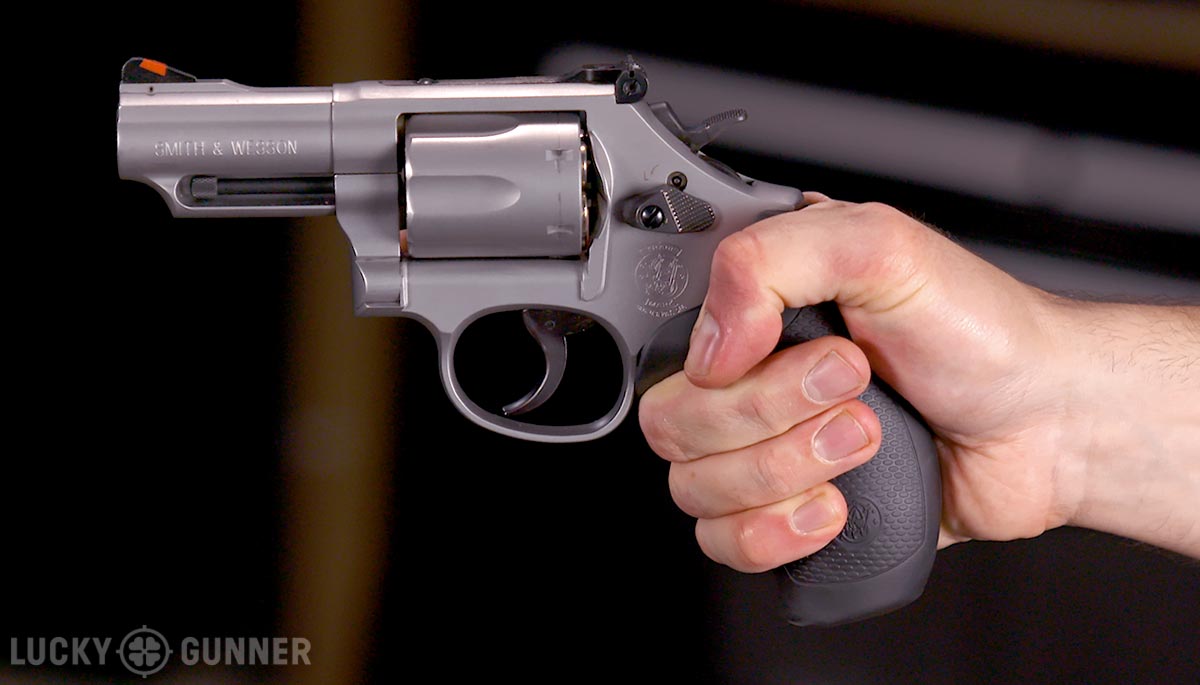
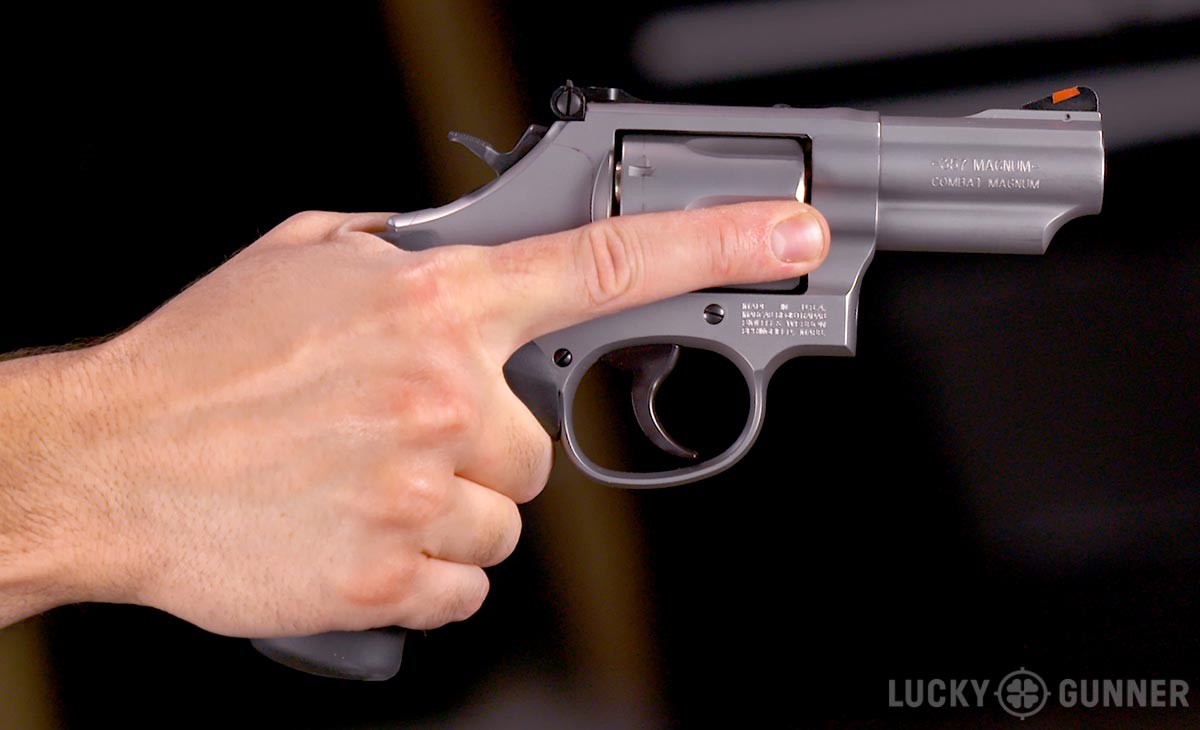
Now bring in your non-dominant hand. Wrap the fingers around the front of the fingers on your other hand. The top of your index finger should be touching the bottom of the trigger guard. Tuck in your non-dominant thumb and hold it on top of your other thumb. The final two-handed grip will look like this:
There are multiple ways to grip a revolver, and there is no one “correct” method. The technique that works for you will depend on your hand size and the size and shape of the gun’s grip. The technique above is usually a good start, though. Whatever grip you eventually adopt, just be sure to keep your fingers off the cylinder so that it can turn freely. Also don’t place any fingers in front of the cylinder, because they may get burned by the hot gasses that rapidly escape from that area when the gun is fired.
Once you’ve established a grip and you want to fire, squeeze the gun as hard as you can without making the barrel shake. Bring the gun up to eye level as you point it at the target. Now your index finger can move to the trigger. Press the trigger straight to the rear with steady even pressure without moving the gun. Congratulations, the gun has fired and you have now put a hole in something! Press the trigger again if you wish to fire another shot and you can keep doing that until all rounds have been fired and you get a “click” instead of a “bang.”
After you have fired the revolver, you will need to remove the spent shell casings from the cylinder. This works just like unloading the gun but with one little difference. Open the cylinder, transfer it to your non-dominant hand, and turn it upside down, but don’t try to catch the casings with your other hand. They’re going to be hot if you have just fired the gun, so simply let them fall to the ground. Some of the casings might fall out on their own, but probably not all of them. So use the palm of your dominant hand and strike the ejector rod once. Don’t be timid, but you don’t have to hit it with a lot of force, either. The ejector rod will force the remaining casings to fall to the ground.
Now the cylinder is empty and you can point the muzzle back at the ground and load it up again if you want to keep shooting. If you’re at a shooting range and you’re done shooting for the time being, but you’re not ready to put the gun away yet, leave the cylinder open, and put the gun on the table with the barrel pointed down range. If you’d like to learn some techniques for rapidly reloading the revolver using a speed loader, check out our posts on reloading techniques and different types of speed loaders.
Cocking and De-cocking
If your revolver has an exposed hammer, you have the option of manually cocking the hammer first before you fire. This is called single action shooting and it makes the movement of the trigger short and light and easy to shoot compared to the longer and heavier double action trigger (the default mode of firing if you do not first cock the hammer). I think it’s fine if you want to shoot the gun single action at the shooting range for fun, but if you are practicing for self-defense, I recommend you work on getting good at the double action trigger instead. When the hammer is cocked, it’s just too easy to make the gun go off when you didn’t mean for it to, especially if you’re already nervous or scared and even more so if you’re an inexperienced shooter.
In the event you find yourself holding a cocked revolver that you do not want to fire, you will need to manually decock it. Hold the grip with your dominant hand and place your index finger (or another finger) from your non-dominant hand between the hammer and the frame. This finger will serve as a “hammer block” and will prevent the gun from discharging if the hammer slips while you’re decocking it. Next, pull back on the hammer with your thumb and press the trigger to release the hammer. Move your finger away from the trigger and ease the hammer forward a little until it’s resting against the index finger you’re using to block the hammer. Then slowly roll your finger up and out of the way as you lower the hammer until it comes to rest on the frame.
If you want to learn more about using a revolver, be sure to check out our other revolver articles. And when you decide to take your revolver out to the range, keep in mind you can get your ammo from Lucky Gunner and have it shipped right to your front door.



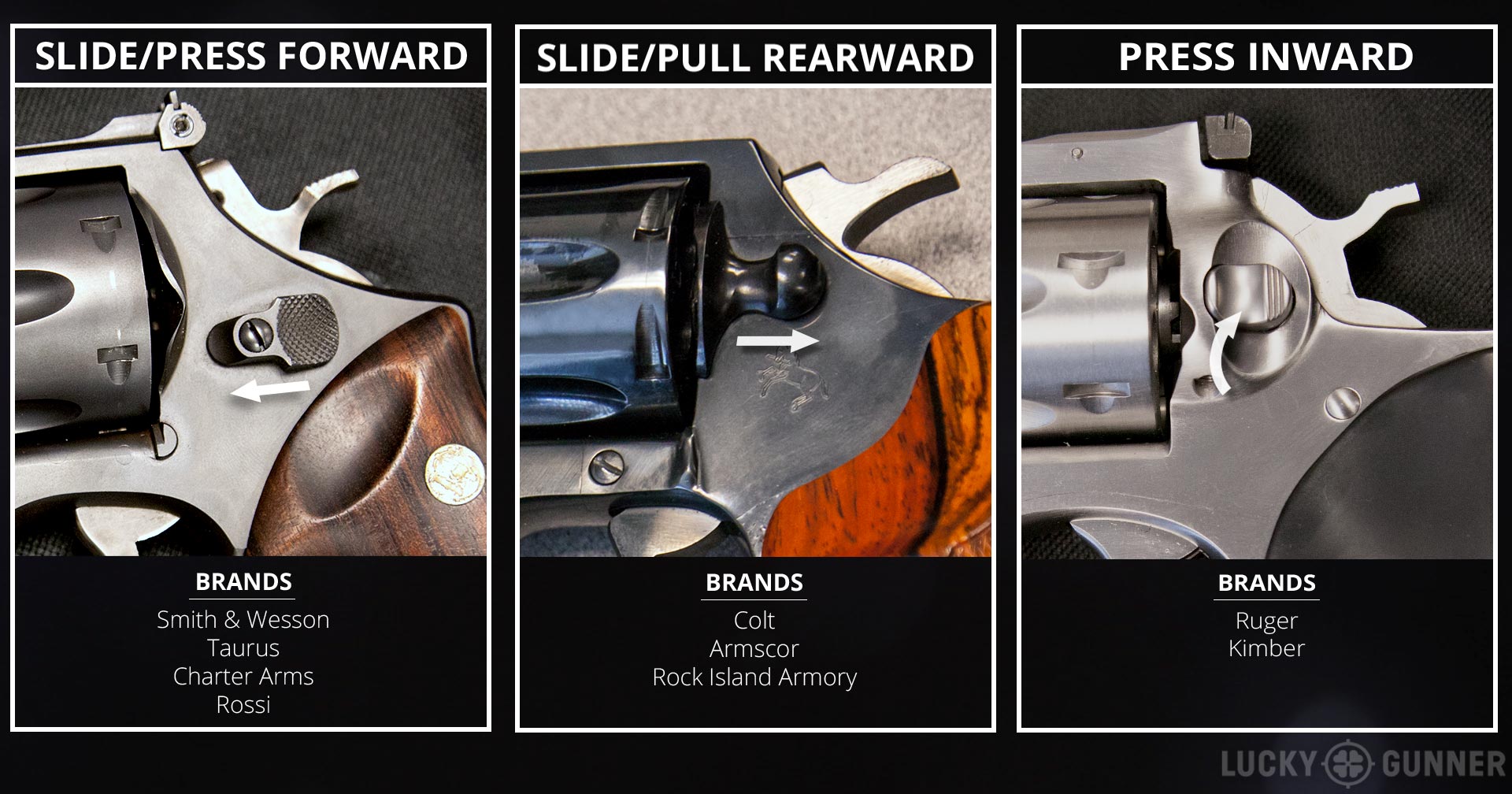
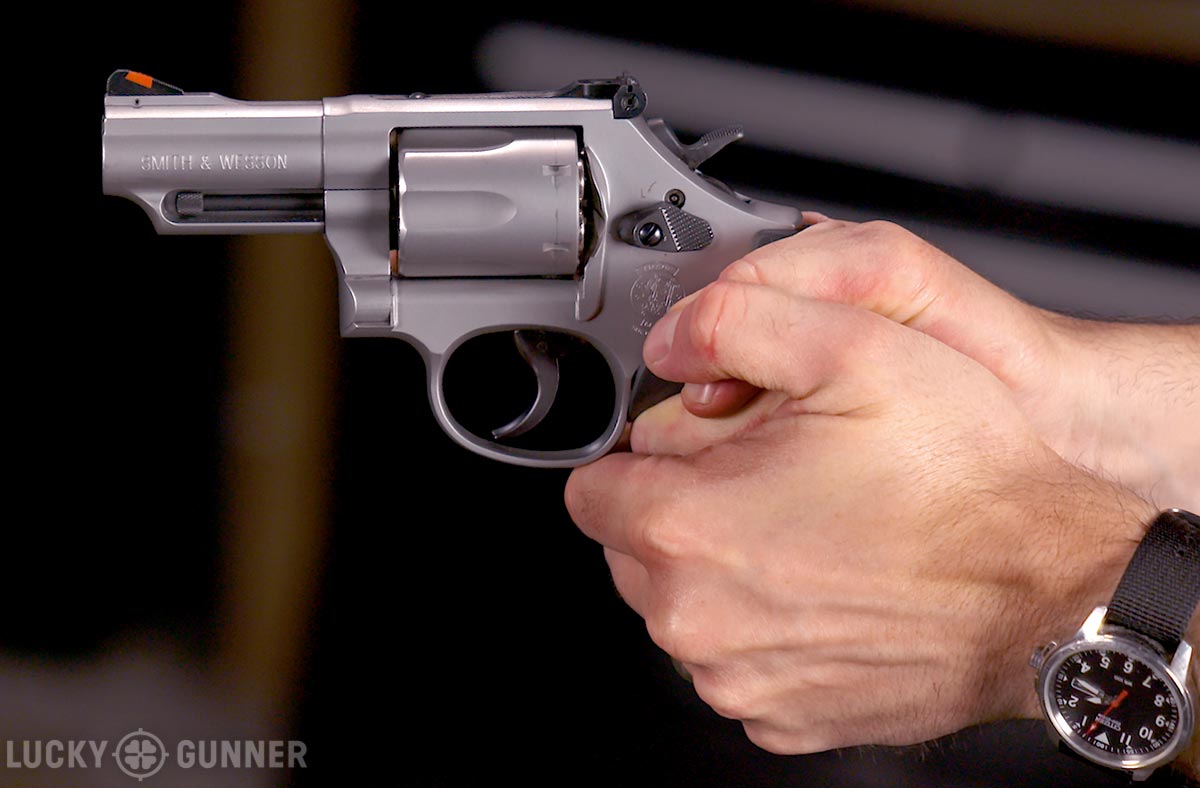
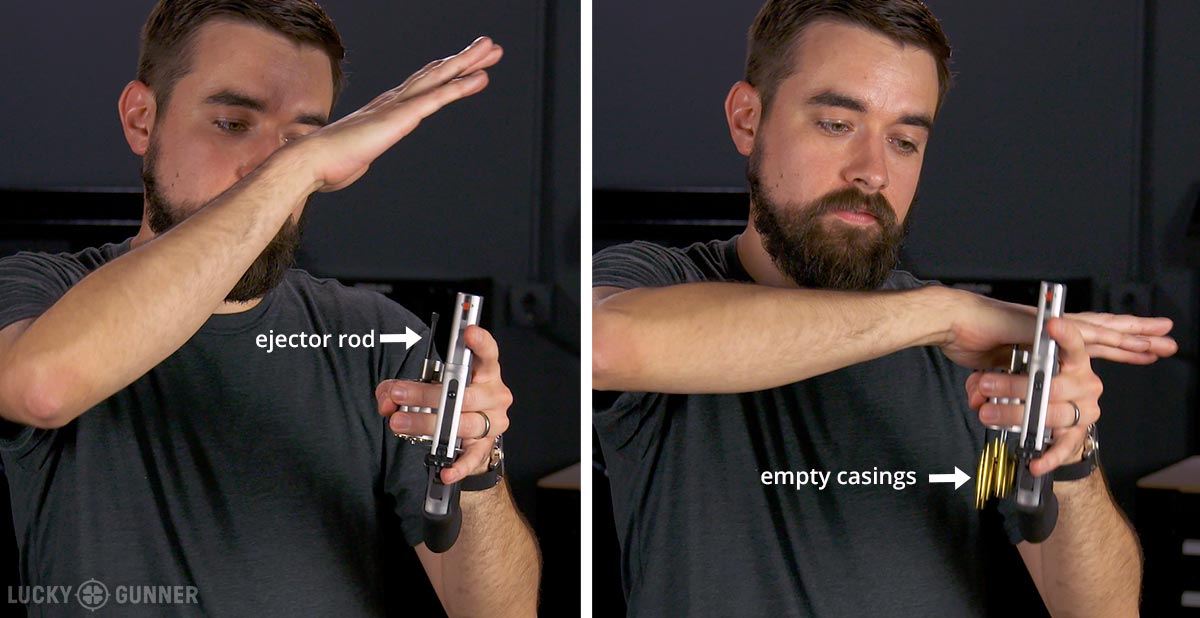
Excellent… as always! I sure appreciate the time and effort you put into each and every topic/video. Keep it up! 🙂
Thanks, Toby!
Extend the arm out and slightly to the side when dumping brass. That way if you move quickly you wont fall if you step on the brass. Sometimes the brass will roll when you step on it and you will fall hard on your Obama taking you out of action
You might even shoot yrself accidentally in the Obama. Just sayin’.
Looking at the gun used in this article raises a question in my mind. Is Smith & Wesson going to begin using two piece barrels for all their revolvers? I guess if I want to buy a new S&W revolver, I’ll be forced to stick to the “Classics” series. Which IMHO is not a bad thing, anyway.
Hickok45 has a nice informational video on those S&W 2-piece barrels. While I prefer the classics as well, the 2-piece barrel engineering is pretty solid and arguably makes a better barrel. Downside is that you won’t be able to remove your own barrel, but how many of us do that anyway?
Thanks for the reply. I’ll check out the video.
Thank you for showing how to safely decock a cocked revolver. I see a lot of articles make comments like, “most people don’t even know how to safely decock a revolver,” but I think this is the first time I’ve seen someone take the time to try correcting that.
Aren’t the leftie instructions for opening cylinder backwards? I use my left thumb to unlock cylinder, and right index to push cylinder open.
There are at least 4 ways for a lefty to open a revolver cylinder that I know of and probably another 5-6 minor variations of each. The method that the article describes is a viable method, but certainly not the only one.
In my experience as an instructor, it’s best to teach one good method. If you show a beginning student four methods, he will try all four, usually get the steps mixed up, and not perform any of them well. It’s best to say, “This method works well.” After the student becomes proficient in one method, then you can show him the variants. But he always has one method he knows well that he can fall back on.
(You can replace “he” and “him” with “she,” “xe,” or whatever as you wish.)
As a lefthander, I should point out that, generally, we are more capable with our right hand than righthanders are with their left. This is due to the world being oriented to the use of the right hand for most every function.
With that in mind, I suggest that the gun be slapped directly into the right hand, and then open the cylinder using the right thumb on the button. I normally push the cylinder using the two middle fingers, actually wrapping them around it, with the two end fingers holding the top of the gun for stability.
At this point, you have the option of operating the ejector rod with the left thumb (if not in a rush) or smacking it with the palm of the right hand. (You could be grabbing a speedloader with your right hand at the same time as using the thumb, but Murphy will cause some empty brass to hang up if you do!)
Rotate the gun to a nearly muzzle down orientation, and wrap the left thumb around the cylinder, allowing the two middle fingers to swing up to the underside of the topstrap for stability. (You have four fingers holding the gun stable during all manipulations) This leaves a pocket in the left palm to hold loose ammo to speed up the re-loading process, or catch cartridges that get fumbled. Use the thumb to rotate the cylinder as needed to make clearance for ammo to align with the chambers.
One of the drawbacks to holding the gun in the right hand is that this is probably where you are carrying your spare ammo. Most dump pouches or speedloaders are carried opposite the gun. Don’t make things more difficult for lefties.
An additional complication is that loading with the left hand obscures the alignment of the ammo to the chambers, as you are now looking directly at them, instead of the 30-45* angle you see when held in the right hand.
I like it.
I don’t know if you’re 100% correct in your assertion that “[m]ost dump pouches or speedloaders are carried opposite the gun.” When I carried a revolver for a living, my speedloaders were on the “gun” side (for me, the right side), in front of the holster. I was taught (and later taught others) to grab the speedloader with the “gun” hand while the revolver was in the “off” hand having the empties smacked out of it.
Just the complexity of reloading a revolver goes far to explain the popularity of autopistols.
I am mixed-handed (not the same as ambidextrous) but primarily use my left hand, including shooting. I transfer the revolver to my right hand and open the cylinder with my right thumb, then eject the empties with my left hand. Pretty basic I guess. I grew up with wheelies and love ’em to no end. Charter Arms has a left-handed revolver but that would seem awkward to me after 45 years of shooting with the cylinder opening to the left. I can easily reload with my left hand and then quickly transfer it back to my left hand, no problemo. BTW, I really love Wheel Gun Wednesdays. Keep on keepin’ on!
thank you Chris
Awesome all the articles.Keep it up!
Thank you for this excellent tutorial
Great article Chris! How is the newer 2.75 inch 66 holding up? Can we expect a review in the future?
Sometime in the next month or two.
I’ve had revolvers for decades. A review of the basics is always worthwhile. Thanks.